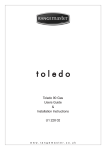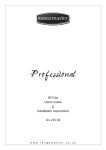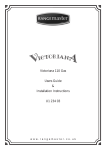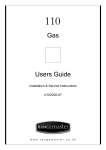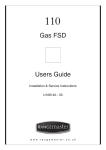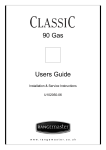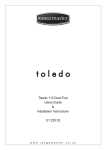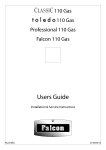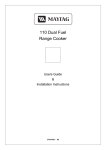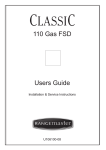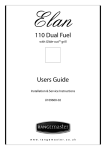Download Rangemaster Classic 110 Technical data
Transcript
Classic 110 Gas Users Guide & Installation Instructions U1 208 03 Contents Contents Page 2 2 Minute Tour Page 3 The hotplate burners Page 8 The griddle Page 8 The Warmer Page 8 The grill Page 8 The ovens Page 9 Main Oven shelves Page 9 The Handyrack Page 9 ‘S’ (Slow) cooking Page 10 Oven cooking guide Page 11 Cooking using the timer Page 12 The clock Page 13 Cleaning your cooker Page 14 Moving your cooker Page 16 Troubleshooting Page 18 General Safety Instructions Page 20 Installation Page 22 Circuit Diagram Page 30 Technical Data Page 31 2 2 Minute Tour Be safe You need clean fresh air - so does your cooker. Burner flames produce exhaust gases, heat and moisture. Make sure that the kitchen is well ventilated: keep natural ventilation holes open or install a powered cooker hood that vents outside. If you have several burners on or use the cooker for a long time, open a window or turn on an extractor fan. For more detail see the Installation Instructions. If you have not used a gas cooker before, we recommend you read pages 20-21 where we describe some basic guidelines on how to use a gas cooker safely. Gas and Electricity on Make sure that the gas supply is turned on and that the cooker is wired in and switched on. The cooker needs electricity. Peculiar smells When you first use your cooker it may give off a slight odour. This should stop after a little use. HOTPLATE BURNERS The drawing by each knob indicates which burner that knob controls. Push in and turn a knob to the large flame symbol ( ) and press the igniter button or light with a match. 1 Simmering aids, such as asbestos or mesh mats, are NOT recommended. They will reduce burner performance and could damage the pan supports. 4 More about the burners on page 8 Adjust the flame height to suit by turning the knob. On this cooker the low position is beyond high, not between high and off. The small flame marks the ‘low position’. Turn the knob towards it after the contents of a pan have boiled. 2 Avoid using unstable and pans that may tilt 5 misshapen easily and pans with a very small base diameter e.g. milk pans, single egg poachers. The minimum pan diameter recommended is 120mm (about 43/4"). 3 Make sure flames are under the Using a lid will help the 3 pans. contents boil more quickly. Pans and kettles with concave bases or down turned base rims should not be used. The Wok burner is designed to even heat over a large 6 provide area. It is ideal for large pans and stir frying. For heating smaller pans the smaller burners may be more efficient. 2 Minute Tour - continued The Griddle More about the griddle on page 8 The griddle fits a single pan support, front to back. It is designed for cooking food on directly. Don’t use pans of any kind on it. The griddle surface is nonstick and metal cooking utensils (e.g. spatulas) will damage the surface. Use heat resistant plastic or wooden utensils. 1 2 Don’t put it crossways - it will not fit properly and will be unstable. Don’t put it on the Wok burner - it is not designed to fit the Wok burner pan support. Always leave space around the of 5 minutes before 4 maximum adding food. Leaving it longer Preheat the griddle for a for the gases to escape. 5 griddle Never fit two griddles side by may cause damage. The controls can be turned to a lower position simply by turning the control knobs towards the lower position marked with the small flame symbol. side. Large pans should also be spaced well apart. The maximum pan base diameter is 250mm (10in). 4 Position the griddle over the hotplate burners resting on the pan support. The griddle can be lightly brushed with cooking oil before use. Light the hotplate burners. Adjust the flame heights to suit. 3 THE GRILL More about the grill on page 8 CAUTION: Accessible parts may be hot when the grill is in use. Young children should be kept away. The burner does not glow red food cooks from the heat of the flame. The first time you light the grill there may be a little smoke given off - this is perfectly normal. Remove the pan from the bottom of the grill compartment. 1 2 Natural gas cookers LP gas cookers Press in the grill knob, turn to After placing your food on the grill tray pan, slide the grill pan onto the side supports just below the burners. Make sure it is pushed right in and touches the back stop. 3 The grill has a special safety device with stops the flow of gas to the grill large flame symbol ( ) and 4 the press the igniter button or light goes out. Turn the knob to the large flame symbol ( ). Press 4 ifinthetheflame grill knob. This lets gas through to the burner. Keep holding the with a match. knob pressed in and press the igniter button or light with a match. Keep holding the button for about 10 seconds If when you let go of the control knob the burner goes out, the safety device has not held in. Turn off the grill and wait one minute then try again this time holding in the button for slightly longer. The low position, marked with the small flame symbol, is beyond high, not between high and off. 5 Never close the grill door when the grill is on. For best results preheat for 2 minutes with the grill pan in position. After placing your food on the grill pan grid, slide the grill pan onto the side supports just below the burners. Adjust the flame height to suit by turning the knob. 6 7 The grill pan grid can be turned over to give two grilling positions. Make sure it is pushed right in and touches the back stop. 2 Minute Tour continues over the page... 5 2 Minute Tour - continued THE OVEN More about the oven on page 9 Push in and turn the knob controlling the oven to Gas Mark 9. The oven will light automatically. 1 Turn the control knob back to the Mark you wish to cook on and for best results pre-heat the oven for 15 minutes before placing your dishes in it. 2 The two ovens in your cooker the our special ‘Heatflow’ 3 use system. Because the oven burner is not hidden under the oven base you will see the burner flames at the back of the oven - this is perfectly normal. Initially the gas will burn with a small flame but after approximately one minute the flame will become larger indicating that the oven is full on. 4 Dishes cooking on the central shelf will cook at the gas mark indicated on the knob. Dishes placed above the central position will be cooked at approximately one gas Mark higher, dishes cooked below approximately one gas Mark lower. You can therefore cook dishes requiring different gas Marks at the same time. 5 6 You can use the timer to turn the oven on and off. Check clock is set to time of day. To set the time of day More about the clock on page 13 Press and hold as above. At the same time, press (-) or (+) until the correct time shows. Don’t forget it’s a 24 hour clock. If you make a mistake or press the wrong button, turn off the power supply for a minute or two and start again. 6 Slow cooking Handyrack More about slow cooking on page 10 More about the Handyrack on page 9. The ‘S’ setting is a very low temperature for slow cooking, overnight or while you are out or at work. The ‘S’ setting can also be used for keeping food warm. The Handyrack fits to the left hand oven door only. Food cooking on it is easy to attend to, because it’s accessible when the door is open. It can be fitted at two different heights. One of the oven shelves must be removed and the other positioned to suit. To fit the Handyrack, locate one side of it on the door bracket. Oven light Press the appropriate button to turn on one of the oven lights. If one of the oven lights fail, turn off the power supply before you change the bulb. See the ‘Troubleshooting’ section for details on how to change an oven light bulb. Storage Warmer Use the warmer for keeping food warm while the final touches are put to a meal. Turn the control knob anticlockwise to the ‘On’ position. The ‘HOT’ indicator lights up. For best results, pre-heat a covered serving dish for 10 minutes before adding food to it. Then spring the other side out to clip it onto the other bracket. 7 The bottom drawer is for storing oven trays and other cooking utensils. It can get very warm, don’t store anything in it which may melt or catch fire. The drawer can be removed completely by pulling it right out and up. The hotplate burners The Warmer You should read ‘hotplate burners’ in the ‘2 Minute Tour’ before all the following information The Warmer can be used for keeping food warm while the final touches are put to a meal. For best results preheat a covered serving dish for 10 minutes on the Warmer before adding the food. If a burner flame goes out, turn the control knob off and leave it for one minute before relighting it. Turn the control knob clockwise to the 'On' position. The 'HOT' indication light glows on the Warmer. You can remove the burner parts for cleaning, see page 14. You should wipe the enamel top surface of the cooker around the hotplate burners as soon as possible after spills occur. Try to wipe them off while the enamel is still warm. CAUTION:- If a crack in the Warmer surface becomes visible, due to accidental damage etc., isolate the appliance from the electricity supply immediately by turning it off at the wall and arrange for its repair. Avoid using unstable and misshapen pans that may tilt easily and pans with a very small base diameter e.g. milk pans, single egg poachers. DO NOT RECONNECT THE COOKER TO THE ELECTRICITY SUPPLY UNTIL AFTER REPAIR! The minimum pan diameter recommended is 120mm (about 43/4"). Smaller pans will be unstable. The grill Pans and kettles with down turned base rims should not be used. You should read ‘grill’ in the 2 Minute Tour’ before all the following information The griddle Never close the grill door while the grill is on. You should read ‘griddle’ in the 2 Minute Tour before all the following information Don’t leave the grill on for more than a few moments, without the grill pan underneath it. Use the following heat settings as a guide for griddle cooking. High/medium: Drop scones, Bacon, Chops, Steak, Burgers. Medium/low: Potato cakes, Eggs, Fish cakes. For best results, especially on toast, preheat the grill with the grill pan in the cooking position for two minutes before use. The grill trivet can be removed and the food placed on it while you are waiting for the grill to preheat. The grill pan grid can be turned over to give two grilling positions. Experience will soon familiarise you with the correct setting to use for cooking. You can brown the top of dishes cooked in the oven, under the grill. Remove the grill trivet and place the dish onto the base of the grill pan. Slide the grill pan along the floor of the grill cavity. After cooking allow the griddle to cool before cleaning. Don’t put it on the Wok burner - it is not designed to fit the Wok burner pan support. 8 The ovens Oven shelves You should read ‘the oven’ in the ‘2 Minute Tour’ before all the following information The wire shelves should always be pushed firmly to the back of the oven. Baking trays with food cooking on them should be placed level with the front edge of the oven’s wire shelves. Other containers should be placed centrally. Keep all trays and containers away from the back of the oven, as overbrowning of the food may occur. the shelf guard should be at the back pointing upwards For even browning, the maximum recommended size of a baking tray is 320mm (12 l/2") by 305mm (12"). The oven shelves can be easily removed and refitted. When the oven is on, don’t leave the door open for longer than necessary, otherwise the knobs may get very hot. Both ovens are protected by a safety cut off, which reduces the supply of gas to the oven if the flames go out, e.g. an interruption to the mains supply. • Always leave a ‘fingers width’ between dishes on the same shelf This allows the heat to circulate freely around them. • Plates can be warmed in the ovens on the ‘S’ setting. The ‘S’ setting can be used to keep foods hot for 3-4 hours after ‘normal’ cooking, without drying out or overbrowning. • The self cleaning oven liners (see Cleaning your cooker) work better when fat splashes are avoided. Cover meat when cooking. To refit the shelf, line up the shelf with a groove in the oven side and push the shelf back until the ends hit the shelf stop. Lift up the front so the shelf ends clear the shelf stops, and then lower the front so that the shelf is level and push it fully back. • To reduce fat splashing when you add vegetables to hot fat around a roast, dry them thoroughly or brush lightly with cooking oil. • Sufficient heat rises out of the oven while cooking to warm plates in the grill compartment. • If you want to brown the base of a pastry dish, preheat the baking tray for 15 minutes before placing the dish in the centre of the tray. • Where dishes may boil and spill over during cooking, place them on a baking tray. The Handyrack You should read ‘the oven’ in the ‘2 Minute Tour’ before all the following information The maximum weight that can be held by the Handyrack is 5.5kg (12lb). It should only be used with the supplied meat tin, which is designed to fit the Handyrack. Any other vessel could be unstable. 9 When the Handyrack is used in its highest position, other dishes can be cooked on the bottom shelf position of the oven or standing on the base of the oven The oven control settings and cooking times given opposite are intended to be used only as a guide. Individual tastes may require the temperature to be altered to provide a preferred result. When the Handyrack is used in its lowest position, other dishes can be cooked on the second shelf position of the oven or standing on the base of the oven. Always leave at least one runner space between shelves when 2 tier cooking. Place baking trays, individual cake tins or baking dishes centrally on the oven shelf. For best results pre-heat the oven until the oven indicator light goes out. The roasting tray supplied with the oven fits into the Handyrack. ‘S’ (Slow) cooking The ‘S’ setting is a low temperature setting. You can cook on ‘S’ throughout, or use a 30 minute ‘boost’ period at gas Mark 6 and then ‘S’ cook. Once the oven has been loaded and the ‘S” setting is in operation resist the temptation to open the oven door. Heat will be lost and the cooking time extended. When roasting joints, poultry or pot roasting, always cook at Mark 6 for 30 minutes at the beginning of the cooking period. You can ‘S’ cook for periods of 6 to 12 hours. This technique is particularly useful if you want to cook a dish overnight or while you are out at work during the day. Frozen foods must be thoroughly thawed out before ‘S’ cooking. A meat thermometer is recommended for checking that a joint or poultry is sufficiently cooked. Insert the probe through the thickest part of the meat. The temperatures to be expected are as follows.Beef Whole poultry should not be cooked on ‘S’. Chicken casseroles are fine. rare medium well done Lamb Pork fresh cured Poultry Veal Casseroles must be brought to boiling point on the hotplate immediately before ‘S’ cooking. Poultry and rolled joints should not be stuffed before cooking. The stuffing should be cooked separately. Poultry and pork should be cooked in the top half of the oven, and other meats not lower than shelf position 4. A roasting joint should be covered with cooking foil, or with a roasting bag to reduce shrinkage and retain juices. Should further browning be necessary, uncover the meat and increase the temperature to Mark 4 for a short period. Cut root vegetables into small pieces unless cooking whole, e.g. jacket potatoes. Cover dishes tightly with a lid or foil to prevent evaporation and transfer of flavour. 10 60°C/ 140°F 71°C/ 160°F 77°C/ 170°F 82°C/ 180°F 88°C/ 190°F 77°C/ 170°F 90°C/ 195°F 77°C/ 170°F Oven cooking guide Meat GAS SHELF POSITION MARK FROM TOP APPROXIMATE COOKING TIME Beef (no bone) Lamb Pork and Veal 3 6 3 6 3 6 3-4 3-4 3-4 3-4 2-3 3-4 30-35mins. per 500g.+30-35 mins. 20-25mins. per 500g.+20-25 mins. 30-35mins. per 500g.+30-35 mins. 25-30mins. per 500g.+25-30 mins. 35-40mins. per 500g.+35-40 mins. 25-30mins. per 500g.+25-30 mins. Thoroughly thaw frozen joints before cooking. Meat may be roasted at Mk. 7 and the cooking time adjusted accordingly. For stuffed and rolled meats, add approx. 10 min. per 500g. or cook at Mk. 6 or 20min, then Mk. 3 for the remainder. 3 6 3 6 3 6 3 6 3-4 3-4 3-4 3-4 4 4 4 4 20-25mins. per 500g.+20-25 mins. 15-20mins. per 500g.+15-20 mins. 25-30mins. per 500g.+25-30 mins. 20mins. per 500g.+20 mins. 20mins. per 500g.+20 mins. 15mins. per 500g.+15 mins. 25-30mins. per 500g. 20mins. per 500g. For stuffed poultry, you could cook at Mk. 6 for 20mins. and then Mk.3 for remainder. Don’t forget to include the weight of the stuffing. For fresh or frozen prepacked poultry, follow instructions on the pack. Thoroughly thaw frozen poultry before cooking. 1-2 3-4 2-4 hours according to recipe. 7 2 Large tin 30-35 mins. Individual, 10-20 mins. 5 5 2 2 Fillets 15-20 mins. Whole 15-20mins. per 500g. Steaks according to thickness. 4 45-50mins. per 500g. of mixture. Poultry Chicken (2.3kg) Turkey (4.5kg) (over 4.5kg) Duck/ duckling Casseroles Yorkshire Pudding Fish Cakes Very rich fruit 1 Christmas/ wedding etc. Fruit 180mm tin 2 Fruit 230mm tin 2 Madeira 180mm 3 Queen cakes 5 Scones 7 Victoria sandwich 180mm tin 4 230mm tin 4 4 4 4 2 & 4 or 3 2 & 4 or 3 2 to 21/2 hours. Up to 31/2 hours. 80-90 mins. 15-25 mins. 10-15 mins. 2 & 4 or 3 2 & 4 or 3 20-30mins. 30-40 mins. When two tier cooking leave at least one runner space between shelves. Position the baking tray with the front edge along the front of the oven shelf. Rich fruit cakes made with selfraising flour should be cooked on Mk.4 for the first half hour at least and then finished at the setting shown. Desserts Shortcrust tarts 6 Fruit pies 6 Tartlets 6 Flaky/rough puff 7 Puff pastry 8 Meringues ‘S’ Baked egg custard 3 Baked sponge pudding 5 Milk pudding 1-2 2&4 2-3 2-3 2-3-4 2-3-4 3 3 3 3 40-60 mins. on pre-heated tray. 35-45 mins. 10-20 mins. according to size. 20-40 mins. according to size. 20-40 mins. according to size. 11/2 to 2 hrs. 45-60 mins. 40-45 mins. 2-3 hrs. 11 If cooking more than one tart at the same time, swap them over at approx. 25 mins. For even browning the maximum size of baking tray recommended is 320mm x 305mm. This ensures free heat circulation. If cooking a two tier load, when the top tray is removed, the tray in the lower position should be raised to the higher shelf, or the trays interchanged, for the remaining cooking time. Cooking using the timer The timer can be used to turn just one oven or both on and off automatically. The start and stop time must be the same for both ovens but different cooking temperatures can be set. If you want to turn one of the ovens on at the same time as the timer is set for automatic cooking, you must wait until the timer has turned on the oven/ ovens first. Then you can adjust either of them manually in the normal way. You can set the oven to turn on any time over the following 24 hour period. If you want to cook more than one dish, choose dishes which require approximately the same time. However, dishes can be ‘slowed down’ slightly by using small containers and covering them with aluminium foil, or ‘speeded up’ slightly by cooking smaller quantities or placing in larger containers. Very perishable foods such as pork or fish should be avoided if a long delay period is planned, especially in hot weather. Don’t place warm food in the oven. Don’t use an oven already warm. Don’t use if an adjoining oven is warm. Avoid using wine or beer if there is a delay period, as fermentation may take place. To avoid curdling, cream should be added to dishes just before serving. Fresh vegetables which may discolour during a delay period should be coated in melted fat or immersed in a water and lemon juice solution. Fruit pies, custard tarts or similar wet mixtures on top of uncooked pastry are only satisfactory if there is a short delay period. Dishes containing leftover cooked meat or poultry should not be cooked automatically if there is a delay period. Whole poultry must be thoroughly defrosted before placing in the oven. Check that meat and poultry are fully cooked before serving. 12 The clock To set the correct time of day. To start and stop the oven automatically See the ‘2 Minute Tour’ at the beginning of this guide. Before you set the clock, you must have two numbers clearly in mind. The ‘cook period’, which is the period of time you want the oven to cook. To time something that’s cooking (minute minder) The ‘stop time’, which is the time of day you want the oven to stop cooking. You cannot set a start time directly - this is set automatically by setting the cooking period and stop time. Press and hold as above. At the same time press (-) or (+) until the time you want to cook for is shown, as below. Press and hold as above. At the same time press (-) or (+) until your required ‘cook period’ shows. You can check time remaining by pressing and cancel the beeper by pressing To stop automatically Use when you have started the oven manually. Press and hold as above. At the same time press (-) or (+) until your required ‘Stop Time’ shows. AUTO will show in the display. When your cooking is finished the beeper sounds. TURN THE OVEN KNOB TO 0 FIRST, then press once to stop the beep, press again to return to manual cooking. Then press and hold as above. At the same time press (-) or (+) until your required ‘stop time’ shows. AUTO will show in the display. Set the oven to the required temperature. When your cooking is finished the beeper sounds. TURN THE OVEN KNOB TO 0 FIRST, then press once to stop the beep, press again to return to manual cooking. If you are out, don’t worry about the beeper going off, it stops after a while. When you return, TURN THE OVEN KNOB TO 0 FIRST, then press twice, to return to manual cooking. AUTO is showing, you want to reset to manual cooking. When cancelling an automatic setting, any cooking time already set must be returned to 0.00 before you can return to manual, by pressing the button. 13 Cleaning your cooker Essential information Hotplate burners Some models have a separate trim ring, which fits on the burner head. Before thorough cleaning isolate the electricity supply. Remember to switch on the electricity supply before use. Never use paint solvents, washing soda, caustic cleaners, biological powders, bleach, chlorine based bleach cleaners, coarse abrasives or salt. Don’t mix different cleaning products - they may react together with hazardous results. Recommended cleaning materials are shown in the chart below. The burner heads and caps can be removed for cleaning. Make sure they are absolutely dry before replacing. The LH hotplate If you want to move your cooker for cleaning, see the section called ‘Moving your cooker’. All parts of the cooker can be cleaned with hot soapy water - but take care that no surplus water seeps into the appliance. When refitting the burner head, make sure that the notch lines up with the electrode or hole in the base. Check that the burner head is level and that the cap is fitted centrally on the burner head. The Wok burner The Wok burner is a little more complicated but it also can be taken apart for cleaning. ‡ Indicates how to clean after the oven linings have been removed. See opposite page for how to remove the oven linings * VEA is the Vitreous Enamel Association. Look for aerosols with the VEA label. 14 When reassembling the Wok burner, turn over the large base ring and find the ‘D’ shaped area. The grill pan and grid should be washed in hot soapy water. Stubborn particles may be removed from the grid by using a nylon brush. Control Panel and Doors The control panel and control knobs should only be cleaned with a soft cloth wrung out in clean hot soapy water - but take care that no surplus water seeps into the appliance. Wipe with a clean dampened cloth then polish with a dry cloth. The oven doors should only be cleaned with a soft cloth wrung out in clean hot soapy water. Turn the head until the ‘D’ matches the one on the burner base. Turn the head over and place it on the burner base. To fit the small inner burner, find the larger electrode notch in the burner rim. Line this up with the white ignition electrode and place the inner burner on the large base ring. The Ovens Cleaning is easier if carried out while the oven is still warm. Before cleaning, cover the burner to prevent the burner holes becoming blocked. The inside of the oven and inner door panel can be cleaned using any cleaner bearing the Vitreous Enamel Association (VEA) label. Take care not to disturb the oven thermostat temperature sensor at the top of the oven opening. Now fit the two trim rings, making sure that they are sitting down properly. The enamelled oven burner trim (supplied with some models only) can be removed for cleaning. Griddle Always clean the griddle after use. Allow to cool completely before removing. Immerse the griddle plate in hot soapy water. Use a soft cloth or, for stubborn stains, a nylon washing up brush. The oven burner trim hooks onto the front of the oven burner bracket. NEVER USE CAUSTIC OR ABRASIVE CLEANERS AS THESE WILL DAMAGE THE SURFACE. The Warmer Wipe with a soft cloth that has been soaked in hot soapy water and then wrung out. Avoid using abrasive cleaners, which may mark the glass surface. When refitting make sure that the trim is in the middle of the front of the oven burner bracket. Grill The face of the grill burner will darken with use this is perfectly normal. Any fat or grease will burn off. Do not try to clean it - the small holes could get blocked and affect burner performance. 15 Moving your cooker Switch off the electricity supply. The cooker is heavy, two people may be required to move it. The cooker * fitted with one roller at the front and two at the back. There are also two screw down levelling feet at the front. The front roller, designed for moving the cooker can be wound down. The levelling tool which controls this roller is in the storage drawer compartment. The Oven side linings The oven has removable oven side lining panels that have been coated with special enamel that partly cleans itself. This does not stop all marks on the lining, but helps to reduce the amount of manual cleaning needed. Remove the storage drawer (by pulling it right out and lifting it up slightly) and you should see the levelling tool. The self cleaning panels work better above gas Mark 6. If you do most of your cooking below this temperature, occasionally remove the panels and wipe with a lint free cloth and hot soapy water. The panels should then be dried and replaced and the oven heated at Gas Mark 7 for about one hour. This will ensure the self cleaning panels are working effectively. Your installer may not have left the levelling tool in place. If not, locate it as shown. If you cannot find the levelling tool, contact your installer. Don’t use steel wool (Brillo) or any other materials that will scratch the surface. Don’t use oven cleaning pads. See the front of the installation section of these instructions. Before cleaning the oven, cover the burner at the rear to stop the holes getting blocked as you clean. If they are accidentally blocked, clean them out with thin wire, such as fuse wire. Removing the Oven Linings The lining panels can be removed for cleaning and for cleaning behind. Remove the shelves first. Turn the levelling tool clockwise, two full (180°) turns. It will be stiff. The front of the oven will rise slightly as the roller drops down. Each side of the oven is fixed with four fixing screws. You don’t have to remove the screws to remove the oven linings. Lift each side panel upwards and they will slide off the screws. Then pull them forwards. Open the grill door and right hand oven door so that you can get a good grip on the bottom of the fascia panel as you move the oven. Once the linings are removed, the oven enamel interior can be cleaned. Do not move the oven by pulling the hand rail, door handles or knobs. 16 Move the oven a bit at a time, checking behind it to make sure the gas hose is not caught. Make sure both electricity and gas cables have sufficient slack to move the cooker forward as you go along. If a stability chain is fitted, release it as you ease the cooker out. When you replace the cooker, wind it down off the rollers by turning the levelling tool anticlockwise. This is important. It will stop the cooker moving accidentally, while in use. 17 Troubleshooting Food is cooking too slowly, too quickly, or burning Cooking times may differ from your previous oven. The oven control settings and cooking times are intended to be used only as a guide. Individual tastes may require the gas mark to be altered one gas Mark either way, to get the results you want. Try cooking at a higher shelf position and/or higher Mark. Oven cooking times and temperatures may need to be increased when other burners are in use. Are the oven burner ports blocked with spilt food? The oven is not cooking evenly Do not use a tin or tray larger than 340mm x 305mm. If you are cooking a large item, be prepared to turn it round during cooking. If two shelves are used, check that space has been left for the heat to circulate. When the baking tray is put into the oven, make sure the front edge is level with the front of the shelf. Check that the door seal is not damaged and that the door catch adjusted so that the door is held firmly against the seal. NB the seal is intended to have a gap at the bottom of the door A dish of water when placed on the shelf should be the same depth all over. (For example, if it is deeper at the back, then the back of the cooker should be raised up or the front lowered). If the cooker is not level arrange for your supplier to level it for you. Oven not coming on when turned on manually Is the power on? Is the clock illuminated? If not there may be something wrong with the power supply. Is the clock flashing 0.00? If so set it to the correct time of day. Has the Timer been set to AUTO by mistake? If AUTO is showing on the clock display, press the ‘cook period’ button and reduce any set cooking time showing to 0.00, with the (+) and (-) buttons. Press the button twice. Are the burner flames starting low and then rising to full height? If this does not solve the problem contact a service person. Are the oven burner ports blocked with spilt food? Oven not coming on when automatic cooking Timer set correctly but oven knob left OFF by mistake? Oven temperature getting hotter as the cooker gets older If turning the knob down has not worked or only worked for a short time then you may need a new thermostat. This should be fitted by a service person. Grill Ignition faulty Is the power on? Is the clock illuminated? If not there maybe something wrong with the power supply. See ‘power supply’ section further on. 18 Troubleshooting Grill not cooking properly Are you using the pan and trivet supplied with the cooker? Is the pan being used on the runners, not the floor of the compartment? Is the grill tray pushed fully back to stop? Hotplate ignition or hotplate burners faulty Is the power on? Is the clock illuminated? If not there maybe something wrong with the power supply. See ‘power supply’ section further on. Are the sparker (ignition electrode) or burner slots blocked by debris? Is the burner trim correctly located? Are the burner caps correctly located? See the section entitled ‘Cleaning’ Hotplate burners will not light If only one or all the hotplate burners will not light, make sure that the parts have been replaced correctly after wiping or removing for cleaning. Check that there is not a problem with your gas supply. You can do this by making sure that other gas appliances you may have are working. Do the burners spark when you push the button? If not check the power is on is the clock illuminated? The oven light is not working The bulb has probably blown. You can buy a replacement bulb (which is not covered under the guarantee) from a good electrical shop. Ask for an Edison screw fitting 15w 240v lamp, FOR OVENS. It must be a special bulb, heat resistant to 300 °C. See the HELP leaflet for spares by mail order. There is a glass cover over the bulb which has to be removed before you can replace the bulb. Turn off the power supply. Unscrew the bulb cover by turning anticlockwise and unscrew the bulb. Screw in the new bulb and refit the bulb cover. Power supply. You think there may be a problem with it First check the socket by trying out another piece of electrical equipment in it. If that works, replace the fuse in the cooker plug. Use a 3 amp fuse. Power failure In the event of a failure in the electrical supply the grill and hotplate may be lit using a match. The oven however cannot be used either manually or automatically until power is restored. Oven ignition faulty Is the power on? Is the clock running? - if not there may be something wrong with the power supply. See the section on ‘Checking the power supply’. Check that the electrode and burner slots are not blocked by debris. Has the Timer been set to auto by mistake, or after power cut? Has the Timer been set correctly but oven tap not left OFF by mistake? 19 General Safety Instructions The cooker must be installed by a CORGI registered engineer in accordance with the installation instructions. The installation must comply with the relevant regulations and also the local gas and electricity supply companies requirements. Take care when touching cooker, to minimize the possibility of burns, always be certain that the controls are in the OFF position and that it is cool before attempting to clean the cooker. Use dry oven gloves when applicable using damp gloves might result in steam burns when you touch a hot surface. Never operate the cooker with wet hands. IF YOU SMELL GAS Don’t turn electric switches on or off. Do not use a towel or other bulky cloth in place of a glove. They might catch fire if they touch a hot surface. Don’t smoke Don’t use naked flames Do turn off the gas at the meter or cylinder Clean with caution. If a wet sponge or cloth is used to wipe spills on a hot surface, be careful to avoid steam burns. Some cleansers can produce noxious fumes if applied to a hot surface. Do open doors and windows to get rid of the gas Call your gas supplier. If you are using natural gas in the UK ring British Gas - Trans Co on Do not use unstable saucepans and position the handles away from the edge of the hotplate. 0800 111 999 Babies, toddlers and young children should not be allowed near the cooker at any time. They should never be allowed to sit or stand on any part of the appliance. Teach them not to play with controls or any other part of the cooker. This appliance is designed for domestic cooking only. Use for any other purpose could invalidate any warranty or liability claim. The use of a gas cooking appliance results in the production of heat and moisture in the room in which it is installed. Ensure that the kitchen is well ventilated: keep natural ventilation holes open or install a mechanical ventilation device, (mechanical extractor hood). Never store anything of interest to children in cabinets above a cooker - children climbing on the cooker to reach them could be seriously injured. Clean only parts listed in this guide. In the interests of hygiene and safety the cooker should be kept clean at all times as a build up in fats and other food stuff could result in a fire. Prolonged intensive use of the appliance may call for additional ventilation, for example opening a window, or more effective ventilation, for example increasing the level of mechanical ventilation where present. Always keep combustible wall coverings or curtains etc. a safe distance away from your cooker. The cooker should be serviced by a qualified service engineer and only approved spare parts used. Have the installer show you the location of the cooker control switch. Mark it for easy reference. Always allow the cooker to cool and then switch off at the mains and before cleaning or carrying out any maintenance work, unless specified otherwise in this guide. Do not spray aerosols in the vicinity of the cooker while it is in on. Do not store or use combustible materials, or flammable liquids in the vicinity of this appliance. Do not use water on grease fires. Never pick up a flaming pan. Turn the controls off. Smother a flaming pan on a surface unit by covering the pan completely with a well fitting lid or baking tray. If available use a multipurpose dry chemical or foam-type fire extinguisher. All parts of the cooker become hot with use and will retain heat even after you have stopped cooking. 20 Never leave the hotplate unattended at high heat settings. Pans boiling over can cause smoking and greasy spills may catch on fire. Do not use aluminium foil to cover shelves, linings or the oven roof. Make sure that your kitchen is well ventilated at all times. Use extractor fans or hoods when fitted. Never wear loose-fitting or hanging clothes while using the appliance. Be careful when reaching for items stored in cabinets over the hotplate. Flammable material could be ignited if brought in contact with a hot surface unit and may cause severe burns. Never heat unopened food containers. Pressure build up may make container burst and cause injury. The cooker is designed for cooking foods only and must not be used for any other purpose. Take great care when heating fats and oils, as they will ignite if they get too hot. The oven should NOT be used for heating the kitchen, not only does this waste fuel but the control knobs may become overheated. Use a deep fat thermometer whenever possible to prevent overheating fat beyond the smoking point. When the oven is on DO NOT leave the oven door open for longer than necessary. Never leave a chip pan unattended. Always heat fat slowly, and watch as it heats. Deep fry pans should be only one third full of fat. Filling the pan too full of fat can cause spill over when food is added. If you use a combination of oils or fats in frying, stir them together before heating, or as the fats melt. The specification of this cooker should not be altered. This appliance is heavy, take care when moving it. When the cooker is not in use ensure that the control knobs are in the off position. Foods for frying should be as dry as possible. Frost on frozen foods or moisture on fresh foods can cause hot fat to bubble up and over the sides of the pan. Carefully watch for spills or overheating of foods when frying at high or medium high temperatures. Never try to move a pan of hot fat, especially a deep fat fryer. Wait until the fat is cool. When the grill is on, do not use the top of the flue (the slot along the back of the cooker) for warming plates, dishes, drying tea towels or softening butter. When using an electrical appliance near the hotplate, be sure that the cord of the appliance does not come into contact with the hotplate. If you find a crack in the Warmer surface immediately disconnect the appliance from the supply and arrange for its repair. Take care that no water seeps into the appliance Only certain types of glass, glassceramic, earthenware or other glazed containers are suitable for hotplate cooking; others may break because of the sudden change in temperature. Do not allow anyone to climb, stand or hang on any part of the cooker. 21 Installation Dear Installer Before you start your installation, please complete the details BELOW. If your customer has a problem relating to your installation they will be able to contact you easily. Thank you Installer’s Name Installer’s Company Installer’s Telephone number 22 You must be aware of the following safety requirements & regulations Prior to installation, ensure that the local distribution conditions (nature of the gas and gas pressure) and the adjustment of the appliance are compatible. This appliance shall be installed in accordance with the regulations in force and only in a well ventilated space. Read the instructions before installing or using this appliance. In the UK the regulations and standards are as follows:In your own interest and that of safety, it is law that all gas appliances be installed by competent persons. CORGI registered installers undertake to work to safe and satisfactory standards. Failure to install the appliance correctly could invalidate any warranty or liability claims and lead to prosecution. The cooker must be installed in accordance with All relevant British Standards / Codes of Practice, in particular BS 5440 Part 2 2000, For Natural Gas - BS 6172 : 1990 and BS 6891 : 1998 For LP Gas - BS 5482-1:1994 (when the installation is in a permanent dwelling), BS 5482-2:1977, (when the installation is in a caravan or other non permanent dwelling), or BS 5482-3:1999 , (when the installation is in a boat). The Gas Safety (Installation and Use) regulations 1998. The relevant Building / IEE regulations. Provision of Ventilation This appliance is not connected to a combustion products evacuation device. Particular attention shall be given to the relevant requirements regarding ventilation. The room containing the cooker should have an air supply in accordance with BS 5440 Part 2 : 2000. All rooms require an openable window or equivalent, while some rooms require a permanent vent in addition to the openable window. The cooker should not be installed in a bedsitting room with volume less than 20m3. If it is installed in a room of volume less than 5m3 an air vent of effective area 100cm2 is required; if it is installed in a room of volume between 5m3 and 10m3, an air vent of effective area 50cm2 is required; while if the volume exceeds 11m3, no air vent is required. If there are other fuel burning appliances in the same room, BS 5440 Part 2 : 2000 should be consulted to determine the requisite air vent requirements. Location of Cooker The cooker may be installed in a kitchen/kitchen diner but NOT in a room containing a bath or shower. NOTE: An appliance for use on LPG shall not be installed in a room or internal space below ground level. e.g. in a basement. This appliance is designed for domestic cooking only. Use for any other purpose could invalidate any warranty or liability claim. 23 You will need the following equipment to complete the cooker installation satisfactorily STABILITY BRACKET If the cooker is to be supplied with gas through a flexible hose, a stability bracket or chain must be fitted. GAS PRESSURE TESTER These are not supplied by with the cooker but are available at most builders merchants. FLEXIBLE GAS HOSE MULTIMETER Must be in accordance with the relevant standards. For LP Gas it should be suitable for LPG, capable of 50mbar pressure, 70°C temperature rise and carry a red stripe, band or label. (for electrical checks) You will also need the following tools: 1. Electric drill 2. Masonry drill bit (only required if fitting the cooker on a stone or concrete floor) 3. Rawlplugs (only required if fitting the cooker on a stone or concrete floor) 4. Steel tape measure 5. Cross head screwdriver 6. Flat head screwdriver 7. 4mm & 3mm Allen keys 8. Spirit level 9. Pencil 10. Adjustable spanner 11. Screws for fitting stability bracket 24 Checking the parts Positioning the Cooker The diagrams below show the minimum recommended distance from the cooker to nearby surfaces. The hotplate surround should be level with, or above, any adjacent work surface. Above hotplate level a gap of 75mm should be left between each side of the cooker and any adjacent vertical surface. 3 pan supports Griddle plate Grill pan and trivet Levelling tool and Allen keys 2 Oven burner trims Meat tin Handyrack & main oven shelves Splashback & Plinth For non-combustible surfaces (such as unpainted metal or ceramic tiles) this can be reduced to 25mm. A minimum space of 650mm is required between the top of the hotplate and a horizontal combustible surface. *Any cooker hood should be installed in accordance with the hood manufacturer’s instructions. For safety reasons curtains must not be fitted immediately behind the cooker. We recommend a gap of 1110mm between units to allow for moving the cooker. If a flush fit is required, fit the cooker up to the unit at one side then fit the unit the other side. Unpacking the Cooker Do not take any packaging off the cooker until it is directly in front of the place it is to be installed (unless it will not fit through a door in its outer packaging). Cut the banding straps and lift the cardboard box off the cooker, LEAVING THE COOKER STANDING ON THE BASE PACKAGING. See the loose unpacking sheet. Moving the Cooker The cooker is very heavy. Take great care. We recommend two people manoeuvre the cooker. Ensure that the floor covering is firmly fixed, or removed to prevent it being disturbed when moving the cooker around. You will need the levelling tool. From the back tilt the cooker forward and remove the rear half of the polystyrene base pack. A clearance of 130mm is required if the cooker is near a corner of the kitchen to allow the oven doors to open. 25 Make sure you lower BOTH REAR ROLLERS. There are two adjusting nuts, one for each roller, at both the front bottom corners of the cooker. Unfold the rear edge of pack base tray. Carefully push the cooker backwards off the pack base and into position. Take care not to damage the power cable. Push the cooker close to its final position, leaving just enough space to get behind it. Repeat from the front and remove the front half of the poly base. Pull the drawer out to its furthest point. Lift it up and out. Levelling You are recommended to use a spirit level on a shelf in one of the ovens to check for level. Fit the levelling tool on the rectangular adjuster as shown below. Place the cooker in its intended position taking care not to twist it within the gap between the kitchen units as damage may occur to the cooker or the units. The rollers can be adjusted to level the cooker. To adjust the height of the rear of the cooker use the levelling tool supplied to turn the adjusting nuts at the front bottom corners of the cooker. Adjust the height of the front roller to level the cooker. Turn clockwise to raise the cooker and anticlockwise to lower. LOWER THE FRONT ROLLER by doing 14 complete (360º) turns clockwise. (This means turning and removing the levelling tool 56 times). When you are satisfied with the height and level raise the front of the cooker by one turn of the front roller adjuster. Screw down the front feet to meet the floor. Screw the front roller adjuster anticlockwise to raise the front roller so that the front of the cooker is supported on the feet, not the front roller, to prevent accidental movement of the cooker. Now LOWER THE TWO REAR ROLLERS. First fit the levelling tool on the hexagonal adjusting nut as shown below. Leave the levelling tool on the adjuster with the handle of the tool facing the rear of the cooker, so that the customer can use it if they wish to move the cooker. Replace the drawer by locating on side runners and push in. Make 10 complete (360º) turns clockwise. (This means turning and removing the levelling tool 20 times). Fit the Handles Remove the 4mm Allen screws from the doors with the hexagon key tool. Use the screws to fit the door handles. 26 The handles should be above the fixings. Remove the 4mm Allen screws from the top corners of the fascia and fix the front handrail in position. Gas Connection The Gas supply needs to terminate with a down facing bayonet. The rear cover boxes limit the position of the supply point. Fitting the splash back (optional) Remove the two fixing screws (3mm hexagonal socket head) and nuts that pass through the top of the rear flue grille. Hold the splash back in position. From the rear refit the 2 fixing screws and nuts. Fitting a stability bracket A stability bracket or chain (not supplied with the cooker) should be fitted when the cooker is connected to a flexible gas supply. When fitting a stability bracket read these instructions together with the leaflet supplied with the bracket. A B view from the rear position for gas supply connector appliance gas inlet Because the height of the cooker can be adjusted and each connection is different it is difficult to give precise dimensions. Ideally the house supply bayonet should be in the shaded area shown in the diagram. Although a 900mm hose can be used, a 1250mm hose will allow slightly more flexibility in the positioning of the bayonet and make moving the cooker easier. The hose should be fitted so that both inlet and outlet connections are vertical so that the hose hangs downwards. 1. Place the cooker in its intended position and level the cooker. 2. Draw a pencil line 100mm from the front edge of the levelling feet. 3. Mark the centre line for the bracket by measuring 550mm from the left hand side of the cooker. The connector is located just below the hotplate level at the rear of the cooker. 4. Lower the front roller and move the cooker forward. For Natural Gas the flexible hose must be in accordance with B.S.669. For LP Gas it should be capable of 50mbar pressure, 70°C temperature rise and carry a red stripe, band or label. 5. Measure back from the pencil line 550mm to locate the front edge of the bracket. Fix the bracket to the floor. 6. Measure the height from floor level to engagement edge in back of cooker. Add 3mm to this dimension and assemble the stability bracket to this height. (i.e. from floor level to underside of the top member) and ensure the bracket does not foul the oven burner assembly. If in doubt contact, your supplier. Screw connect the threaded end of the hose into the gas inlet in the underside of the connector block on the back of the cooker. After completing the gas connection, check the cooker is gas sound with a pressure test. When checking for 27 gas leaks do not use washing up liquid - this can corrode. Use a product specifically manufactured for leak detection. Electrical checks EARTH CONTINUITY CHECK The cooker must be disconnected from the power supply. Set your meter to (ohm) on the X1 scale and adjust to zero if necessary. Test the leads from any of the cooker’s earth points (e.g. inside electric box cover) - to the earth pin on the cooker’s plug - resistance should be less than l (ohm). If it is not, check all the earth wires for continuity. Check that all contacts are clean and tight. Re-check. If the resistance is still greater than l (ohm) there may be a problem, consult a qualified electrical engineer. Pressure testing The gas pressure can be measured at the injector of one of the LH hotplate burners. Remove the pan support, burner head and caps. The injector is now accessible. For Natural Gas cookers the pressure should be 20mbar. For LP Gas cookers the pressure should be 29mbar for Butane 37mbar for Propane. POLARITY CHECK Reassemble burner top, making sure it is reassembled in the correct way on the burner body. The cooker must be connected to the power supply. Your meter should be set on 300V ac scale. Test at the cooker terminal block: Electrical Connection 1. Test leads from L to N. Your meter should read approx. 220-240V ac. WARNING: THIS COOKER MUST BE EARTHED. All external wiring must comply with the IEE Regulations for the Electrical Equipment of Buildings. Connection to the electrical supply can be made with either a plug and socket or be permanently wired via a double pole switch. The cooker is supplied with a 3 core cable 2m long. If a replacement cable is fitted it must be 250v high temperature PVC (85°C), 1mm2. Should the plug not fit the socket in your home, it should be removed and replaced with a suitable plug. Note: If a plug is fitted which is not suitable, it must be cut off and disposed of properly. To avoid the risk of electrocution, the plug must not be left where children might find it and plug it into a supply socket. Three pin plugs to BS1363 with a capacity of not less than 13A must be used and fitted with a 3 amp fuse ‘ASTA’ approved to BS 1362. After replacing the fuse the cover must be refitted. If the cover is lost, the plug must not be used until a replacement cover has been obtained from your supplier. The colour of the correct fuse carrier is that of the coloured insert in the base of the fuse recess, or stated elsewhere on the plug. Always state this colour when ordering a replacement fuse carrier. IMPORTANT The wires in the mains lead are coloured in accordance with the following code:GREEN AND YELLOW: EARTH BLUE: NEUTRAL BROWN: LIVE 2. Test leads from L to E. Your meter should read approx. 220-240V ac. 3. Test leads from N to E. Your meter should read approx. 0-15V ac. If the readings are different from these values there is an electrical fault. Rectify any fault and repeat the test. If necessary repeat the test at the supply system socket/spur - if the fault also occurs at this stage then there is a house system fault which requires attention by the Electrical Authority. The customer should be warned NOT to use the appliance until this examination has been carried out. Grill check Open the grill compartment door. Natural gas models Press in the grill knob, turn to the large flame symbol ( ) and press the igniter button or light with a match. LP gas models LP gas models have an FSD with stops the flow of gas to the grill if the flame goes out. Turn the knob to the large flame symbol ( ). Press in the grill knob. This lets gas through to the burner. Keep holding the knob pressed in and press the igniter button or light with a match. Keep holding the button for about 10 seconds If when you let go of the control knob the burner goes out, the safety device has not held in. Turn off the grill and wait one minute then try again this time holding in the button for slightly longer. The wires should be connected into the terminal of your plug as shown: Hotplate check Check each burner in turn. Push in each knob and turn it to the large flame symbol. Press the IGN button, release the button when the burner lights. 28 and using the + button to give a time of 2 minutes. By pressing and releasing the ‘stop time’ button ( ) the stop time is displayed. Add 3 minutes to this time by using the + button. The display will automatically change to show the time of day, the cooking symbol ( ) will go out and (AUTO) will show. Fitting the oven burner trim (supplied with some models only) Push in and turn one of the oven knobs to Mark 9, the timer will run until the ‘cook period’ starts, when the oven solenoid will open and the burner will light automatically. The cooking symbol ( ) will show. At the end of the ‘cooking period’ the solenoid will close, the oven burner will go out and the beeper will sound (the beeper may be stopped by pressing the timer ( ) button). The flashing (AUTO) symbol is a reminder to reset to manual operation. Pressing the reset’ button ( ) once to stop the beep and a second time to return to manual, turn off the oven knob. The loose oven burner trim hooks onto the front of the oven burner bracket. CONTROL KNOB (THERMOSTAT) CHECK Set timer to manual. Check each oven in turn. Push in and turn the control knob to Mark 9. A series of sparks will occur at the oven electrode and when the oven burner lights the sparking will stop. A small flame will appear on the oven burner, but as this flame is ‘sensed’ by the flame supervision device, the gas flow will come on full after a short delay. Heat each oven for 10 minutes at Mark 9 then turn to Mark 1 and check that the flame size has reduced. Turn off each oven and check that the oven burner goes out. Oven check The clock must be set to the time of day before the ovens will work. Fitting the plinth Loosen the 3 screws along the front bottom edge of the cooker. Hook the central keyhole over the central screw. Twist and fit each end keyhole over their respective screws. Tighten the fixing screws. Press and hold as above. At the same time, press - or + until the correct time shows. Don’t forget it’s a 24 hour clock. If you make a mistake or press the wrong button, turn off the power supply for a minute or two and start again. CONTROL KNOB (THERMOSTAT) CHECK If (AUTO) is flashing, press and release the manual ( ) button. Check each oven in turn. Push in and turn the control knob to Mark 9. A series of sparks will occur at the oven electrode and when the oven burner lights the sparking will stop. A small flame will appear on the oven burner, but as this flame is ‘sensed’ by the flame supervision device, the gas flow will come on full after a short delay. Heat each oven for 10 minutes at Mark 9 then turn to Mark 1 and check that the flame size has reduced. Turn off each oven and check that the oven burner goes out. TIMER AND SOLENOID CHECK Automatic Operation of Timer: The gas supply to each oven can be controlled by the timer. Set a ‘cooking period’ time by pressing and releasing the ( ) button Customer care Please complete your details in the inside cover of this Guide. Then replace this Installation Guide back in the Customer Care Pack in the correct position. Please inform the user how to operate the cooker and hand over the Customer Care Pack. Thank you. 29 Circuit Diagram 30 Technical Data This cooker is designed for use on either :NATURAL GAS (Cat I2H ) at 20mbar or LP GAS (Cat I3+ ) Butane 29mbar / Propane 37mbar. NB: THE NATURAL GAS AND LP GAS VERSIONS OF THESE COOKERS ARE DIFFERENT MODELS AND CANNOT BE CONVERTED FROM ONE GAS FAMILY TO THE OTHER. INSTALLER: Please leave these instructions with the User. DATA BADGE LOCATION: Cooker back, serial number repeater badge below oven door opening. Country of Destination: GB/IE Gas Electric Natural Gas 20mbar 220 - 240V 50Hz Butane 29mbar Propane 37mbar (See appliance data badge for test pressures) Dimensions Overall height including optional splashback minimum 1063mm Height to hotplate minimum 893mm Overall width 1100mm See ‘Positioning of Cooker’ Overall depth 648mm Space for fixing See ‘Positioning of Cooker’ Minimum space above hotplate 650mm maximum 1190mm maximum 920mm Connections Gas Rp Electric at rear right-hand side 220 - 240V 50Hz Ratings Hotplate Wok burner Natural Gas Injector L.P. Gas Injector 3.5kW 3.5kW(246g/h) internal 80 external 129 Large Burner 3.0kW 134 Medium Burners 1.7kW 109 Small Burner 1.0kW 75 Ovens 3.2kW 237 Grill 2.73kW 190 Gas burner inputs based on Gross Calorific Value Warmer 160W 31 internal 54 external 77 3.0kW (210g/h) 87 1.7kW (119g/h) 68 1.0kW (70g/h) 51 2.9kW (224g/h) 85 2.73kW (192g/h) 85 160W
































